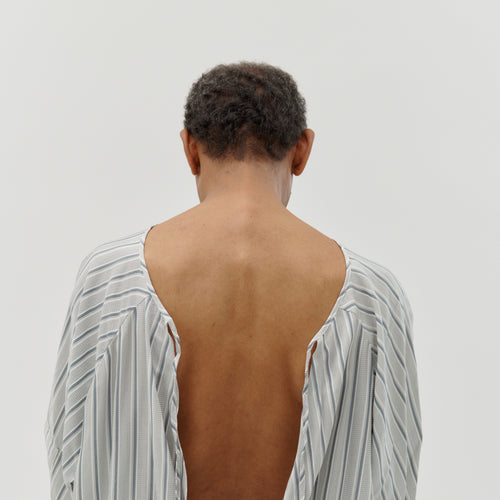
uniforms of the patient
Every item of clothing is based on (body) ideas that are shaped by social fashions, moral value perspectives as well as medical and health policy considerations. People are shaped by clothes.
We can play with clothing and choose for ourselves whether we want to show or conceal messages about our body, mind and lifestyle. Clothing is therefore never non-designed and cannot "not communicate". If a person is forced to wear certain clothing, for example in service (military, nursing) or in fragile circumstances such as illness, this can have a transformative effect on their self-image. This can certainly be desirable, but can also lead to conflicts which, in extreme cases, we can perceive as "vestmental assaults". In settings where wearing specific clothing is not autonomous and self-determined, but due to the rationality of the context, as in the case of a hospital stay, the psychological costs can be high, as the mutual relations (clothing, person, group, context) can lead to alienation. Wearing clothing therefore never remains without consequences. The nursing shirt is no exception here. Like all body-hugging textiles, it sends messages, even if it is created, produced and marketed primarily with health policy and function-oriented ideas in mind. On the website of pflegeoverall24.de (20219), for example, a model is described as follows: "The open back section with practical tie fasteners in the neck and hip area saves nursing time and greatly simplifies work processes in nursing." The clear focus is on advantages such as "quick putting on and taking off without the patient sitting up" (ibid.). Unlike other clothes, the functional claim is not aimed at the wearer of the garment, but at another user group: the caregivers or third care persons. This changed focus is visible in the uniformity of the design and in the functional design of the nursing shirt, so that we can also see the vestimentary object as the uniform of the sick person, which does not necessarily "only" serve the wearer.
While official uniforms such as the white coats worn by doctors offer opportunities for identification and belonging, the uniform of the sick person only offers this to a limited extent. A nursing shirt cannot convey social status either. This seems particularly relevant in the context of palliative care, where healing is not the focus. Unlike with acute illnesses and short-term medical interventions, the irreversibility of the illness and the resulting need for care forces people to redesign their fragile body identities. The redesign of the vulnerable self, like the term palliative care, has material dimensions, because as a vestimentary metaphor, the "pallium" (Latin) refers to a cloak-like cape that, in the sense of the concept of care, is (or should be) placed caringly around seriously ill bodies and fragile identities. Whether the global nursing uniform can be understood as protective or hurtful care apparel is a question that certainly cannot be answered in a blanket and universally valid way. After all, we live in a hyper-individual world in which each person not only lives their life individually, but also falls ill in an equally individual way and leaves life at the end of their days in a very individual way. As time and the health system change, it seems all the more important to think about personal and institutional care textiles, since textiles that can be experienced with the skin not only envelop, touch, camouflage and protect our bodies, but also make statements about our individual and social value systems. Care textiles therefore not only enter into an exchange with ourselves, but also with others. These specific items of clothing also evoke certain actions and non-actions and, like any other fashion, reveal important information non-verbally. We cannot avoid this, no matter what life situation we are in, no matter whether we construct our identities through everyday clothing, workwear, formal wear or hospital clothing, no matter whether we are standing, walking, dancing or lying in hospital beds.
Footnote: This text excerpt comes in large parts from the book contribution "The last shirt has (still) no pockets. A design-anthropological study of the patient shirt by Bitten Stetter," published in the book publication "Kontext Sterben" edited by Corina Caduff, Francis Müller, Eva Soom Ammann and published by Scheiddegger & Spiess, Zurich 2022.
